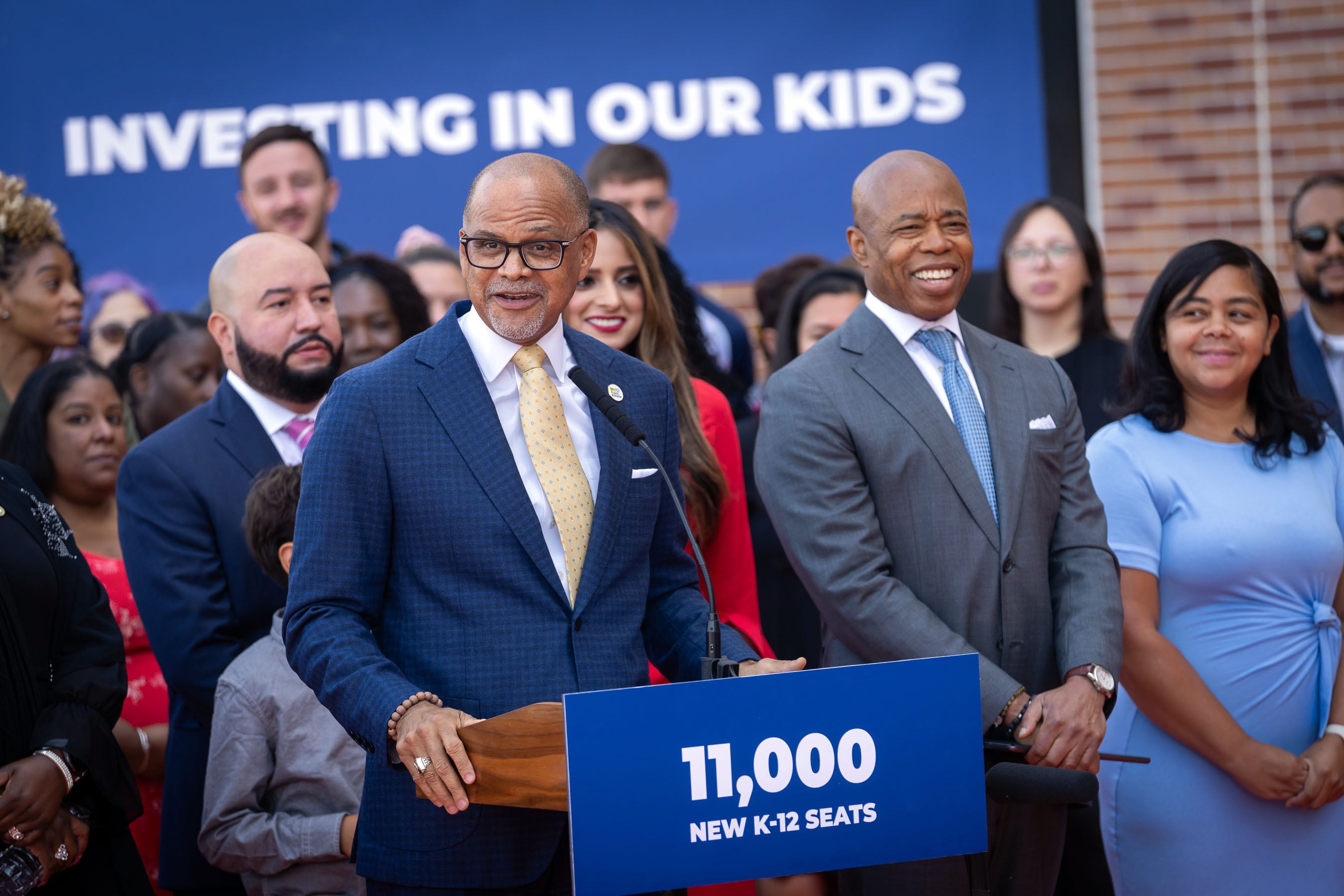Sign up for Chalkbeat New York’s free daily newsletter to keep up with NYC’s public schools.
New York City officials on Wednesday touted the opening of 24 new school buildings serving roughly 11,000 kids when classes begin Thursday – the most new school seats in two decades.
But this wave of new construction won’t come close to solving the city’s looming class size problem. In the coming years, the city will need more space — and teachers — to satisfy the sweeping state law that caps class sizes at 20 for kindergarten to third grade, 23 for fourth to eighth grade, and 25 for high school.
This year, the city will likely remain in compliance without having to do much. The first major test comes in September 2025, when the law requires that 60% of classrooms across the city fall below the caps. Getting there will require a historic reduction in class sizes over the coming year. City officials estimated last year that around 40% of the city’s classes were below the caps, leaving more than 70,000 classrooms above the legal limits.
And the stakes are high: The state can withhold more than $800 million a year in funding for the city school system if it fails to comply with the law, according to city estimates.
But even with next September’s daunting deadline looming, the city has so far stuck with a mostly piecemeal approach.
In its most recent class size plan in July, the Education Department outlined steps that schools can take to bring more classes under the caps, including repurposing space, reassigning teachers, rebalancing class rosters, and considering virtual classes. Officials charged each of the city’s 45 superintendents with bringing an additional 3% of classrooms in their districts under the caps, and for the first time directed $140 million to schools for the sole purpose of reducing class sizes.
But officials have so far stayed away from more sweeping systemwide mandates.
“We don’t think we need to do that in order to stay in compliance next year, so we’re leaving it up to superintendents and principals to think about how they can make progress,” Deputy Chancellor of Operations and Finance Emma Vadehra said in a meeting with parent leaders in June.
Officials also haven’t touched one of the most potentially powerful but controversial levers for reducing class sizes: capping enrollment at oversubscribed schools.
Schools Chancellor David Banks on Wednesday seemed to punt that decision to Mayor Eric Adams.
“We can meet the class size law if we were to cap enrollment at some of the most high profile schools in the city,” he said at Wednesday’s press conference. “Should we be doing that? … Ultimately, the decisions are the mayor’s to make.”
And despite the new funding for class size reduction, the city has so far hired fewer new teachers this year than last, according to Education Department figures. (An Education Department spokesperson clarified after publication that the department is continuing to hire teachers and said the city is on track to ultimately hire more teachers than last year, but didn’t give a final projection.)
The slow pace of progress prompted a coalition of advocates, parents, and educators to pen a letter to the state education department in June warning “it is highly questionable as to whether the city will be able to comply with the annual benchmarks in the class size law, starting next school year and beyond.”
Michael Mulgrew, president of the city teachers union, which was instrumental in lobbying for the 2022 class size law, urged the city to focus first on the hundreds of schools that have space to add classrooms and are motivated to lower class sizes, but need more staff.
According to a city survey, more than 600 of roughly 1,530 principals said they currently have the space they need to fully meet the class size mandate.
“We feel the next phase of this should be about the coalition of those who can” and want to reduce class sizes immediately, Mulgrew said at a Wednesday press conference highlighting a Queens middle school that’s brought all its sixth-grade classes under the cap.
Here’s a preview of what we currently know about what this pivotal school year will look like for class size reduction, and some of the big remaining open questions:
New funding hasn’t translated to spike in new teacher hiring
Education Department officials have pointed to hundreds of millions of new dollars in school budgets – some of which is earmarked specifically for lowering class sizes – as a way to boost teacher hiring.
But critics contend the new funds aren’t logically distributed: Many schools didn’t get enough to hire even one full teacher.
So far, that additional spending hasn’t translated into a noticeable spike in new teacher hiring. Education Department officials said schools have hired an estimated 4,200 new teachers this year, down from an estimated 4,500 last year. (The Education Department spokesperson clarified after publication that the city had hired only 3,500 of its total 4,500 teachers by this time last year.)
Some individual schools that prioritized class size reduction acted early to snap up new teachers, according to union officials. But systemwide, the city has yet to make any progress toward hiring an estimated 10,000 to 12,000 additional teachers needed by the time the law takes full effect in 2028.
At a press conference Wednesday touting the new school construction, Banks sounded a pessimistic note about the prospects of staffing up.
“The question becomes, do you lower your standards to get more teachers, or how much more innovative can you get, you know, to bring on 10 to 12,000 more teachers? It’s not an easy choice,” he said.
Mulgrew said “part of the next phase of this is us having real conversations with SUNY and CUNY about heavy duty teacher recruitment.”
Education Department “not eager” to make enrollment, admissions changes
One of the most potent tools the Education Department has at its disposal to reduce class sizes across the city without hiring new teachers or building new facilities is redistributing enrollment by capping student numbers at oversubscribed schools and steering kids toward under-enrolled ones.
But such policies would likely bring fierce pushback from parents, especially since some of the most overcrowded schools are among the city’s most in-demand.
“It’s something we are not eager to do unless we really need to,” Vadehra told parent leaders in June.
Vadehra didn’t foreclose the possibility of admissions changes for the 2025-26 school year, however.
“This is something we are very much discussing internally,” she said. “We’re very aware that if we’re going to make any large scale shifts, that’s something families need to know this fall, and we expect any changes would happen in compliance with that timeline.”
Officials added that they would work with some individual schools this year to make “small changes” to enrollment for incoming classes to avoid the need for new space.
Part of what might determine whether the city is forced to consider more drastic enrollment changes is whether overcrowded schools qualify for exemptions from the law, which must be approved by the teachers and principals unions.
Mulgrew suggested that in cases where schools are significantly overcrowded and there’s little parent or teacher demand to reduce enrollment, exemptions will be granted, at least temporarily.
“It’s about engaging with those parents,” he said. “We’re not diminishing the number of students that are going to Stuyvesant High School. So at this point, hypothetically, that school would be given a waiver.”
New school construction plans increase, but fall far short of need
The slowest and costliest way the city can shrink class sizes is by building new schools to alleviate overcrowding.
The city recently added $2 billion to the five-year capital plan of the School Construction Authority. And the agency said it’s now explicitly considering class size reduction in decisions about building new facilities.
But that still falls far short of what the city will likely need. Officials estimate that roughly 540 schools will need more space to comply with the law – with some schools needing as many as 60 new classrooms. School construction officials have placed the cost of all that new building in the tens of billions of dollars.
Critics have expressed concerns that many of the existing school construction projects don’t even have locations yet and that they won’t be completed in time to satisfy the requirements of the class size law.
This story has been updated with additional context on teacher hiring numbers provided by the Education Department.
Julian Shen-Berro contributed.
Michael Elsen-Rooney is a reporter for Chalkbeat New York, covering NYC public schools. Contact Michael at melsen-rooney@chalkbeat.org







